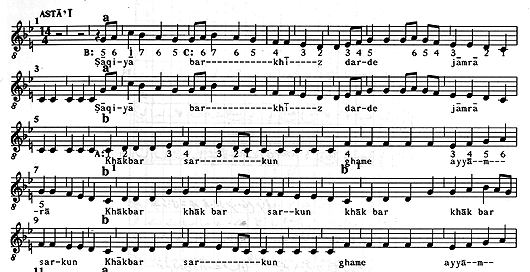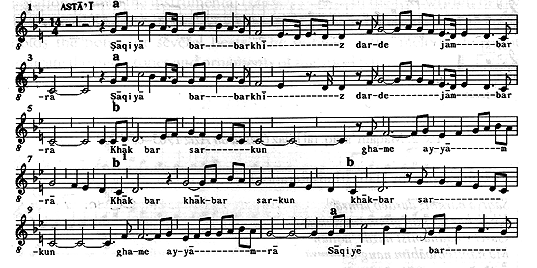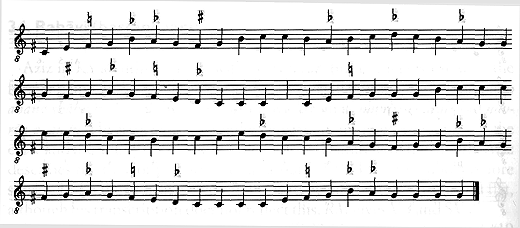EOL Book Review
The book falls into two parts. Part I presents a complete examination of the subject, introducing the historical background, the ethnography of performance, instruments, and musical repertory. Included is a detailed consideration of maqam as suite, as tonal system, and as mode; the formal structure of songs; and indigenous musical theory as formulated in written sources. Part II documents the modal repertory: each of 47 maqams is analysed on the basis of theoretical accounts, notated melodies, and recorded performances, with examples where available of both song melodies and instrumental preludes. Appendices provide additional information: biographical information on 15 important musicians active during the period 1970–1990 (this small number no doubt reflecting the depletion of the tradition); details of manuscripts on Kashmiri music; and notes (including song texts in translation) on the contents of the CD that accompanies the book. The CD’s seven tracks contain seven maqams which were recorded by the author in the 1970s. Each selection is represented by an instrumental introduction and one or two vocal pieces. Several of the pieces recorded correspond with notated examples in the book, and the disc as a whole represents a welcome addition to the meagre discography of Sufyana Musiqi. There are an extensive bibliography and a full index. Sufyana Musiqi, or Sufyana Kalam, is the product of a fertile growth of Islamic mysticism within a culture historically dominated by Hindu (Saiva) Tantrism. Pre-Islamic sources cited by Pacholczyk testify to the strength of Indic musical tradition in Kashmir, and it is worth noting that two of the greatest mediaeval Indian writers on music—Abhinavagupta the commentator on Bharata, and Sarngadeva author of the Sangitaratnakara—were of Kashmiri origin. Not surprisingly, there are many cross-currents between the traditions of maqam and raga in Sufyana Musiqi, notably in the modes themselves. For example, some modes have Indian raga names, others have the names of well-known maqams, and many have both. Pacholczyk suggests that the importation of Indic concepts and terminology into theoretical writings is now a matter of political expediency, and may have been in the past as well (p. 119). The cross-fertilization is already apparent in the earliest song collections and treatises. Nevertheless, the question that Pacholczyk poses at the end of Part I, ‘whether to consider Sufyana an off-shoot of the Indic tradition or a part of the Great Islamic Near Eastern Tradition’ seems somewhat redundant, since as Pacholczyk observes, the answer ‘depends on the criteria we select as the most important’ (p. 122). He emphasises the typically Islamic organization of a maqam performance into a suite of items in different metres, starting with an unmetered instrumental introduction. But a similar organization can also be found in North Indian dhrupad performance, where an unmetered introduction can be followed by a sequence of items in different tals. As in Sufyana Musiqi, the longer and slower tals (Cautal, Dhamar) are followed by shorter, faster ones (Sultal, Tivra). While this is not the only option in dhrupad performance, its existence may well reflect the influence of the ‘Great Islamic Near Eastern Tradition’ on the music of the Indian Mughal court. The performance of a dhrupad composition by unison male voices in relatively unornamented style also has something in common with Sufyana Musiqi. Given the syncretic nature of North Indian classical music, also to some extent now masked by a preference for Sanskritic vocabulary, the Indian connections in Sufyana Musiqi are certainly strong. In view of the hybrid character of Sufyana Musiqi, Pacholczyk is undoubtedly right to analyse it in its own terms from the outset, rather than from the perspective of raga or other traditions of maqam. The comparatively limited number of scale-types commonly used in Sufyana—mostly diatonic with the 3rd and 7th varying in pitch—means that many maqams inhabit the same scale-type, and modal identity therefore rests on other factors. Pacholczyk convincingly shows that these include stock melodic formulae or ‘modules’. His method of identifying the modules is simple but effective: melodic pitches are represented in cipher notation, and the sequence of pitch-numbers are arranged synoptically on the page so that recurring sequences are vertically aligned and thus obvious to the eye. The cipher-notation of the basic modules is then inserted into the staff-notated melodies, transcribed from Kashmiri notation or recorded performance, to show how the modules are used as compositional building-blocks. Where in Indian music, soloistic ornamentation might conceal or make ambivalent the sequence of basic melodic pitches, in Sufyana the instrumental accompaniment (especially the santur) emphasises the melodic skeleton rather insistently, so this method of analysis is well suited to performance practice. [Figure. 1 (analysis); Figure 2 (transcription); Audio. 1.]
Figure 1. Maqam ‘araq, shakl and tal hijaz, module analysis (see
Pacholczyk p. 84, and cf. Figs. 2a, 2b, and Audio 1 below)
Figure 2a. Maqam ‘araq, tal hijaz, transcribed from notation (see
Pacholczyk p. 52, and cf. Fig. 2b)
Figure 2b. Maqam ‘araq, tal hijaz, transcribed from recorded
performance (see Pacholczyk p. 54, and cf. Audio 1) Sufyana/1
It is most refreshing to read an ethnomusicological study that gives pride of place to musical structure while at the same time introducing the historical and ethnographic contexts in some detail. Some readers might have preferred more ethnography and less music analysis; but the author’s approach will be welcomed by readers interested in mode, especially those with a particular interest in maqam or raga. There is ample scope here for comparison with, for example, North Indian ragas, both in general and specific cases where the Kashmiri maqam may represent a transformation or an archaic version of the Indian ‘original’. Pacholczyk does not attempt to go so far: in fact he seems relatively unfamiliar with the Indian modal repertory, failing for example to recognize the well-known raga name Jaijaivanti in the Sufyana maqam Jazvanti. There is indeed some melodic material in common as well as the name, provided we read the minor third of Jazvanti as the major third of Jaijaivanti. This is not the only example where a change of ‘key-signature’ in a Sufyana maqam reveals the melodic phraseology of the corresponding Indian raga: the melody illustrating maqam Ramkali, for example, with a key-signature consisting only of a sharpened fourth, could pass as the North Indian raga Ramkali if we naturalize most of the fourths, and flatten the second, the sixth, and some of the sevenths [Figure 3]. Figure 3. Maqam Ramkali, from Pacholczyk p. 188; accidentals above the
staff added by RW to suggest relationship with North Indian rag Ramkali In some other cases, a shift in the position of the system tonic has the same effect: in maqam Todi, the typical contours of North Indian raga Todi appear if we take the third as the tonic [Figure 4]. Figure 4. Maqam Todi, from Pacholczyk p. 206 (to compare with North
Indian rag [Vilaskhani] Todi, take e' as tonic) The resulting scale moreover is that of Vilaskhani Todi, which is probably a more archaic form of the raga than the alternative Miya ki Todi with sharpened fourth and seventh. What the evolutionary mechanisms were that led to the scalar divergence of certain Sufyana modes and their Indian counterparts, and whether similar relationships exist with Central Asian maqams, remain to be discovered; but the comparison suggested here underlines the importance of melodic modules as identifying ingredients of mode in Sufyana Musiqi, as elsewhere in South Asia. The relationship suggested here between Sufyana maqams and Indian ragas is not unlike that between North and South Indian ragas, where Powers has shown that melodic motifs are of greater significance than scale structure (1970). On the other hand the force of tetrachordal symmetry or ‘melodic consonance’ in the structure and evolution of Indian ragas (Jairazbhoy 1971; Widdess 1995: 210 ff.) may also be at work in Sufyana Musiqi, as a number of Pacholczyk’s examples suggest. Pacholczyk writes that ‘Sufyana seems to be in a state of severe decline’, a decline that he attributes in part to the political instability of the province for two hundred years. Given the recent deterioration in political climate, the outlook for Sufyana Musiqi does not appear optimistic, and it may be that Pacholczyk has documented the tradition at a critical juncture. To have demonstrated its richness and worth, and recorded for posterity so many of its essential materials and structures, is a major achievement. Richard Widdess
References Jairazbhoy, N. A. 1971. The rags of North Indian music: structure and evolution. London: Faber. Powers, H. S. 1970. "An historical and comparative approach to the classification of ragas (with an appendix on ancient Indian tunings)." Selected Reports in Ethnomusicology, i/3.2-78. Widdess, R. 1995.The ragas of early Indian music. Oxford: The Clarendon Press. |
 Sufyana Musiqi:
Sufyana Musiqi:



